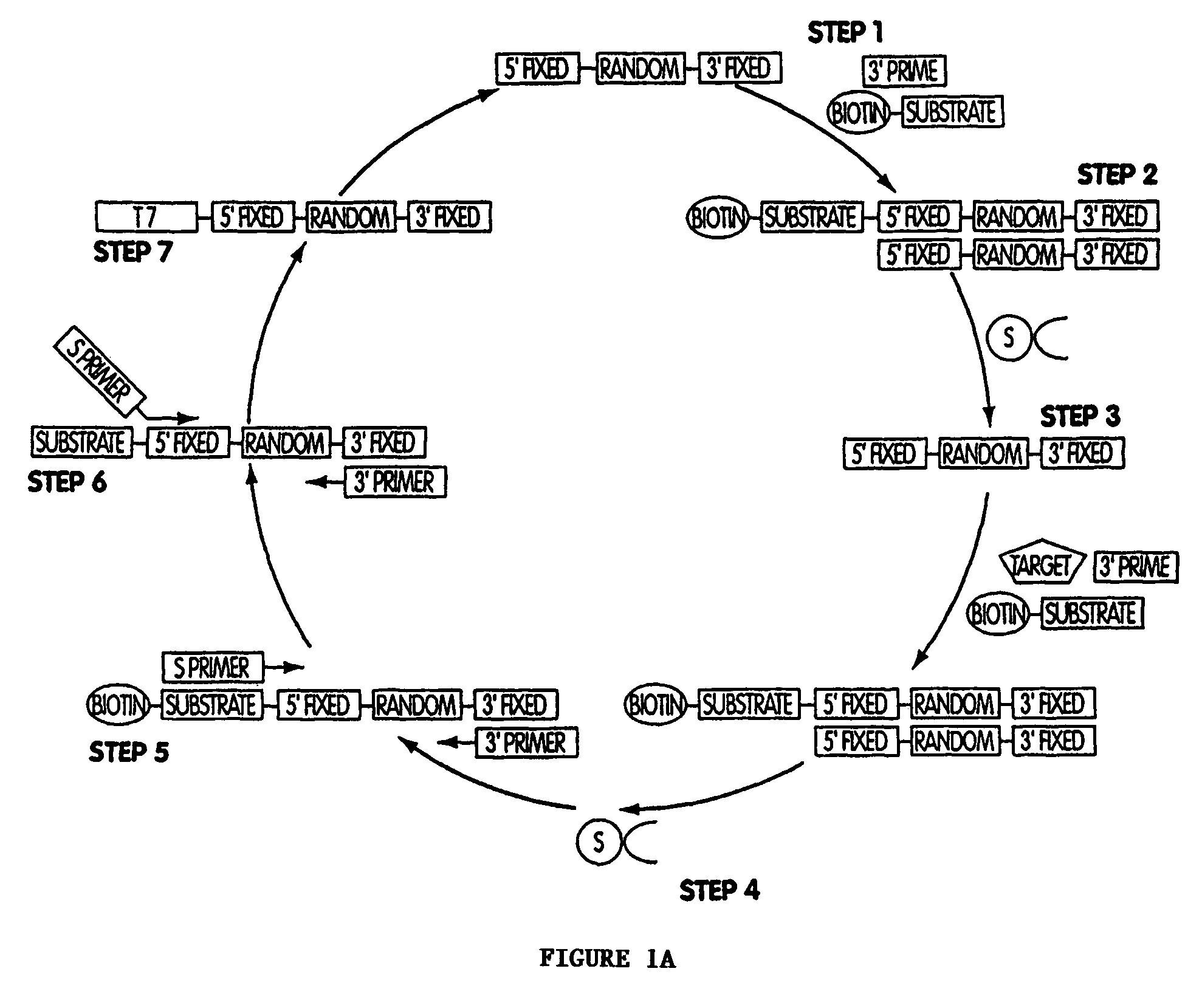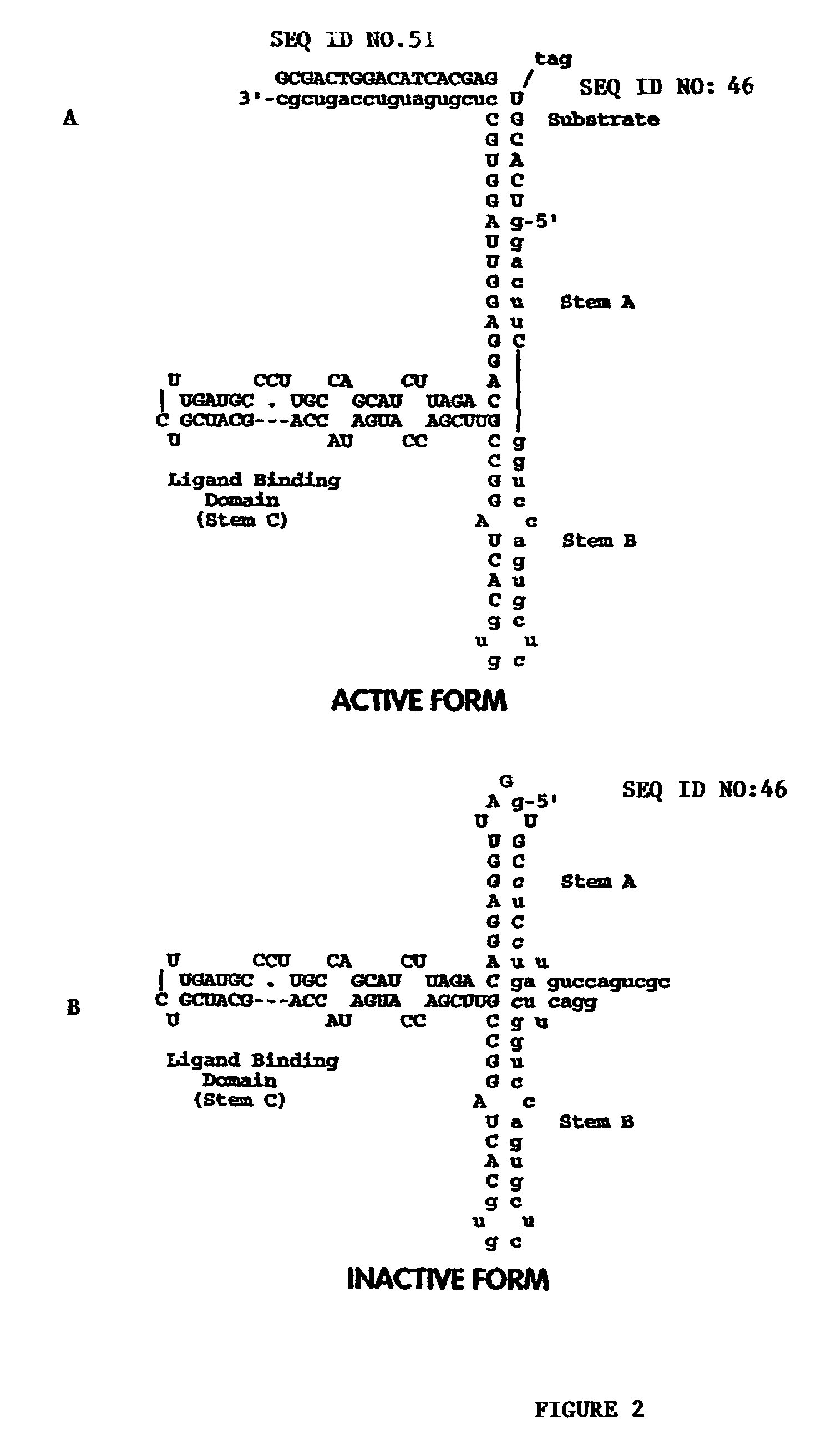Nucleic acid sensor molecules and methods of using same
a sensor molecule and nucleic acid technology, applied in the field of nucleic acids, can solve the problems of antibody-based detection methods, unstable monoclonal antibody fragments, and limited utility of antibody methods such as elisa or competitive ria, and achieve the effect of changing the optical properties of said molecule, increasing the detectable fluorescence of said fluorescent donors
- Summary
- Abstract
- Description
- Claims
- Application Information
AI Technical Summary
Benefits of technology
Problems solved by technology
Method used
Image
Examples
example
Example 1
General Procedures
[0441]A. Generation nucleic acid sensor molecules from pools of ribozymes comprised of randomized linker and target modulation domains.
[0442]Direct selection of nucleic acid sensor molecules. Target modulated nucleic acid sensor molecules are isolated by in vitro selection. Pool of partially randomized ribozymes with 1015–1017 unique sequences serve as the starting point for in vitro selection. As with the engineering approach, both the L1 ligase and hammerhead ribozyme are used as platforms for the selection of allosterically-controlled molecules. Selections are designed to yield ribozymes that specifically respond to any target. Nucleic acid sensor molecules with cross-specificity (i.e. modulated by alternate target molecules, or by alternate ligand-bound states, or by alternate post-translationally modified forms of protein or peptides) are selected against by including the undesired form of the target in an initial negative selection step. The specific...
example 2
Selection for a Nucleic Acid Sensor Molecule Selective for the Estrogen Receptor LBD
[0483]A nucleic acid sensor molecule which is modulated by the estrogen receptor (ER) ligand binding domain (LBD) is obtained by in vitro selection methods to identify candidate nucleic acid sensor molecules that are modulated by an estrogen receptor LBD.
[0484]The full length gene for the estrogen receptor is known. One source of the full-length estrogen receptor clone is Acc. No. M12674 (see also Greene et al., Science 231:1150–54, 1986). The clone includes a 2092 nucleotide mRNA with the sequence presented in Table 3 below:
[0485]
TABLE 31gaattccaaa attgtgatgt ttcttgtatt tttgatgaag gagaaatact gtaatgatca(SEQ ID NO:9)61ctgtttacac tatgtacact ttaggccagc cctttgtagc gttatacaaa ctgaaagcac121accggacccg caggctcccg gggcagggcc ggggccagag ctcgcgtgtc ggcgggacat181gcgctgcgtc gcctctaacc tcgggctgtg ctctttttcc aggtggcccg ccggtttctg241agccttctgc cctgcgggga cacggtctgc accctgcccg cggccacgga ccatgaccat301gaccctccac accaa...
example 3
Selection for a Library of Nucleic Acid Sensor Molecules which Signal the Presence of all Known Nuclear Hormone Receptor LBDs:
[0492]A wide variety of nuclear hormone receptor (“NHR”) ligand binding domains and their ligands, many of which are described in Table 5 below, are known for which a nucleic acid sensor molecule can be selected.
[0493]
TABLE 5SymbolDescriptionLigandAIB3nuclear receptor coactivator RAP250; peroxisomethyroid hormoneproliferator-activated receptor interacting protein;thyroid hormone receptor binding proteinARandrogen receptor (dihydrotestosterone receptor;dihydroxytestosterontesticular feminization; spinal and bulbar muscularatrophy; Kennedy disease)C1Dnuclear DNA-binding proteinESR1estrogen receptor 1estrogenESR2estrogen receptor 2 (ER beta)estrogenESRRAestrogen-related receptor alphaestrogen and TFIIBESRRBestrogen-related receptor betaestrogen and TFIIBESRRGestrogen-related receptor gammaestrogen and TFIIBHNF4Ahepatocyte nuclear factor 4, alphaHNF4Ghepatocyte n...
PUM
| Property | Measurement | Unit |
|---|---|---|
| optical signal | aaaaa | aaaaa |
| detectable fluorescence | aaaaa | aaaaa |
| fluorescent energy transfer | aaaaa | aaaaa |
Abstract
Description
Claims
Application Information
 Login to View More
Login to View More - R&D
- Intellectual Property
- Life Sciences
- Materials
- Tech Scout
- Unparalleled Data Quality
- Higher Quality Content
- 60% Fewer Hallucinations
Browse by: Latest US Patents, China's latest patents, Technical Efficacy Thesaurus, Application Domain, Technology Topic, Popular Technical Reports.
© 2025 PatSnap. All rights reserved.Legal|Privacy policy|Modern Slavery Act Transparency Statement|Sitemap|About US| Contact US: help@patsnap.com



